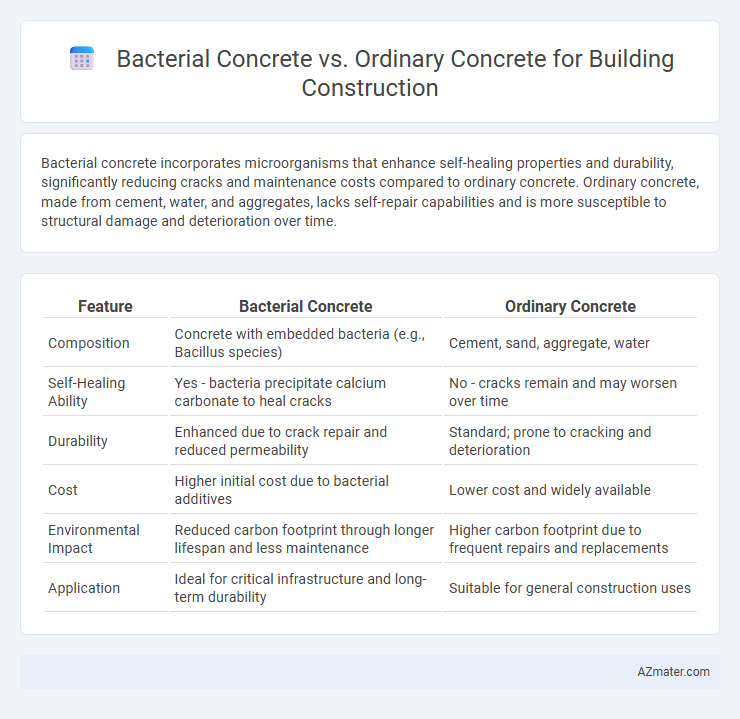Bacterial concrete incorporates microorganisms that enhance self-healing properties and durability, significantly reducing cracks and maintenance costs compared to ordinary concrete. Ordinary concrete, made from cement, water, and aggregates, lacks self-repair capabilities and is more susceptible to structural damage and deterioration over time.
Table of Comparison
| Feature | Bacterial Concrete | Ordinary Concrete |
|---|---|---|
| Composition | Concrete with embedded bacteria (e.g., Bacillus species) | Cement, sand, aggregate, water |
| Self-Healing Ability | Yes - bacteria precipitate calcium carbonate to heal cracks | No - cracks remain and may worsen over time |
| Durability | Enhanced due to crack repair and reduced permeability | Standard; prone to cracking and deterioration |
| Cost | Higher initial cost due to bacterial additives | Lower cost and widely available |
| Environmental Impact | Reduced carbon footprint through longer lifespan and less maintenance | Higher carbon footprint due to frequent repairs and replacements |
| Application | Ideal for critical infrastructure and long-term durability | Suitable for general construction uses |
Introduction to Bacterial Concrete and Ordinary Concrete
Bacterial concrete incorporates specific bacteria like Bacillus pasteurii that precipitate calcium carbonate, enhancing self-healing and durability compared to ordinary concrete composed primarily of cement, water, sand, and aggregates. Ordinary concrete often suffers from cracking and permeability issues, leading to structural deterioration over time. The bio-mediated approach in bacterial concrete significantly improves crack resistance and longevity, making it a sustainable alternative in modern building construction.
Composition and Materials Used
Bacterial concrete incorporates specific strains of bacteria such as Bacillus pasteurii to produce calcium carbonate that enhances its self-healing properties, while ordinary concrete primarily consists of cement, water, sand, and aggregates without biological additives. The composition of bacterial concrete includes microbial agents embedded in the cement matrix along with nutrients like calcium lactate to activate bacterial metabolism and facilitate crack repair. Ordinary concrete relies solely on Portland cement hydration for strength, lacking the biological components that enable bacterial concrete to improve durability and reduce maintenance through microbial-induced mineral precipitation.
Mechanism of Strength Development
Bacterial concrete enhances strength development through the microbial-induced calcium carbonate precipitation (MICP) process, where specific bacteria within the concrete produce calcite that fills micro-cracks and pores, improving density and durability. Ordinary concrete relies solely on the hydration of cement, forming calcium silicate hydrate (C-S-H) gel that provides compressive strength but is more susceptible to micro-cracking and carbonation. The biomineralization in bacterial concrete not only increases compressive strength but also slows deterioration, making it a superior choice for long-lasting building structures.
Durability and Lifespan Comparison
Bacterial concrete significantly enhances durability and lifespan compared to ordinary concrete by utilizing microbial-induced calcite precipitation to self-heal cracks and reduce permeability, effectively limiting water ingress and chemical attack. Studies show that bacterial concrete can extend structural lifespan by 20-30% due to its increased resistance to environmental degradation and corrosion of reinforcement steel. Ordinary concrete, while widely used, is more prone to microcracking and faster deterioration under harsh conditions, leading to frequent maintenance and shorter service life.
Crack Healing Abilities
Bacterial concrete incorporates specific bacteria that precipitate calcium carbonate, enabling self-healing of cracks and enhancing durability compared to ordinary concrete, which lacks this capability and is prone to irreversible crack propagation. Studies indicate that bacterial concrete can autonomously heal micro-cracks up to 0.5 mm wide, significantly reducing maintenance costs and improving structural longevity. Its crack healing abilities also contribute to reduced permeability and improved resistance to environmental degradation, making it a superior choice for sustainable building construction.
Environmental Impact and Sustainability
Bacterial concrete significantly reduces carbon footprint by utilizing microbial-induced calcium carbonate precipitation to heal cracks, enhancing durability and reducing maintenance needs compared to ordinary concrete. This bio-based approach minimizes cement consumption, lowering CO2 emissions linked to cement production, a major contributor to global greenhouse gases. Sustainable construction benefits from bacterial concrete's longer lifespan and reduced resource depletion, promoting eco-friendly infrastructure development.
Cost Analysis and Economic Feasibility
Bacterial concrete incorporates microbial-induced calcite precipitation to enhance crack self-healing, potentially reducing long-term maintenance costs compared to ordinary concrete. Initial costs for bacterial concrete are higher due to expensive bio-agent integration and specialized production techniques, yet its durability and reduced repair needs improve economic feasibility over a building's lifespan. Life cycle cost analysis often shows that bacterial concrete provides better return on investment through decreased maintenance expenses and extended structural longevity.
Applications in Building Construction
Bacterial concrete enhances durability and self-healing properties, making it ideal for repairing cracks in structural elements, reducing maintenance costs in bridges, tunnels, and high-rise buildings. Ordinary concrete remains widely used for foundational and general structural applications due to its cost-effectiveness and established performance. The integration of bacterial concrete is increasingly favored in critical infrastructure projects requiring extended lifespan and reduced environmental impact.
Challenges and Limitations
Bacterial concrete faces challenges such as higher production costs and complexity in mixing bacterial spores uniformly, which can limit large-scale application compared to ordinary concrete. Its effectiveness depends on specific environmental conditions like temperature and pH, restricting its use in diverse climates and requiring specialized maintenance. Ordinary concrete, while more economical and widely used, suffers from durability issues like cracking and corrosion, which bacterial concrete aims to address but has yet to fully overcome in practical construction settings.
Future Prospects and Research Directions
Bacterial concrete, embedded with microbial-induced calcium carbonate precipitation, offers enhanced self-healing properties and improved durability compared to ordinary concrete, promoting longer structural lifespan and reduced maintenance costs in building construction. Future research is concentrated on optimizing bacterial strains for varied environmental conditions, scaling production methods, and integrating nanotechnology to further enhance concrete strength and crack resistance. Exploring eco-friendly bio-concrete formulations aligns with sustainable construction goals, positioning bacterial concrete as a transformative material for resilient infrastructure development.

Infographic: Bacterial concrete vs Ordinary concrete for Building construction
 azmater.com
azmater.com